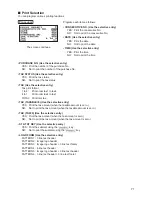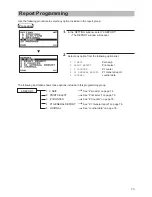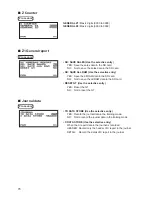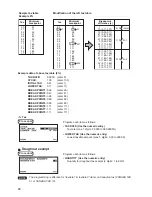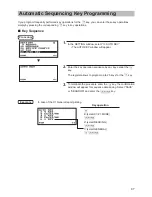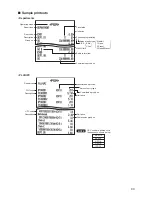
85
<Sample tax table>
Tax table: 6%
To program a tax table, first make a table like the right table shown below.
Taxes
Range of sales amount
Minimum breakpoint
.00
.01
.02
.03
.04
.05
.06
.07
.08
.09
.10
.11
.12
.13
.01
.11
.23
.39
.57
.73
.89
1.11
1.23
1.39
1.57
1.73
1.89
2.11
Maximum breakpoint
.10
.22
.38
.56
.72
.88
1.10
1.22
1.38
1.56
1.72
1.88
2.10
2.22
to
to
to
to
to
to
to
to
to
to
to
to
to
to
T
Q
M1
M2
A: Difference between the
minimum breakpoint and
the next one (¢)
–
10 (0.11 - 0.01)
12 (0.23 - 0.11)
16 (0.39 - 0.23)
18 (0.57 - 0.39)
16 (0.73 - 0.57)
16 (0.89 - 0.73)
22 (1.11 - 0.89)
12 (1.23 - 1.11)
16 (1.39 - 1.23)
18 (1.57 - 1.39)
16 (1.73 - 1.57)
16 (1.89 - 1.73)
22 (2.11 - 1.89)
B: Non-cyclic
C: Cyclic-1
D: Cyclic-2
From the tax table, calculate the differences between a minimum break point and the next one (A). Then,
from the differences, find irregular cycles (B) and regular cycles (C and D). These cycles will show you the
following items necessary to program the tax table:
T:
The tax amount collected on the minimum taxable amount (Q)
→
INITIAL TAX
Q:
The minimum taxable amount
→
LOWER TAX
M1:
The maximum value of the minimum breakpoint on a regular cycle (C)
We call this point “MAX point.”
M2:
The maximum value of the minimum breakpoint on a regular cycle (D)
We call this point “MAX point.”
M:
Range of the minimum breakpoint on a regular cycle: difference
→
CYCLE
between Q and M1 or between M1 and M2
Example data of tax table (6%)
TAX RATE:
6.0000 (enter 6)
CYCLE:
1.00
(enter 100)
INITIAL TAX:
0.01
(enter 1)
LOWER TAX:
0.11
(enter 11)
BREAK POINT1:
0.23
(enter 23)
BREAK POINT2:
0.39
(enter 39)
BREAK POINT3:
0.57
(enter 57)
BREAK POINT4:
0.73
(enter 73)
BREAK POINT5:
0.89
(enter 89)
BREAK POINT6:
1.11
(enter 111)
NOTE
If the tax is not provided for every cent, modify the tax table by setting the tax for every
cent in the following manner.
When setting the tax, consider the minimum breakpoint corresponding to unprovided tax to be the same as
the one corresponding to the tax provided on a large amount.

